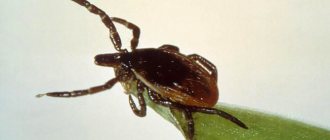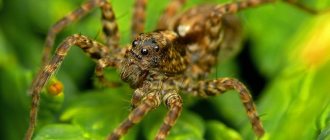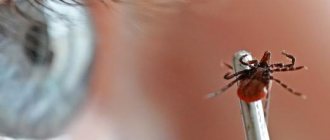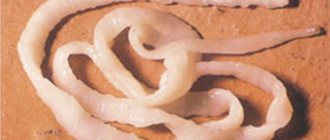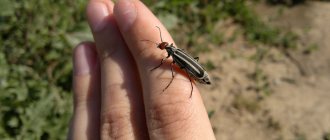When the long-awaited summer arrives, people happily go out into nature, gardeners go to their garden plots in flocks, and children run carefree barefoot on the grass. But in all this natural splendor, and even at home, a person faces a subtle danger in the form of ticks. Forewarned means protected, and in our article there are the most dangerous ticks in the world, which can cause irreparable harm to human health, and in some cases their bites are fatal.
Interesting fact! It is incorrect to call mites insects, because they belong to the class of arachnids, although together with insects they belong to the phylum of arthropods.
Ixodid ticks / Ixodida
The most dangerous family of ticks, numbering more than 650 species, belongs to the large order Ixodida. These small creatures are dangerous because they are carriers of diseases that are fatal to humans - tick-borne encephalitis and tick-borne borreliosis (Lyme disease).
These tiny animals live in all corners of our planet, and even in Antarctica they parasitize the bodies of penguins and birds. Adults grow up to 4 mm, and when filled with blood, reach a size of 10 mm. In Russia, ticks are found almost everywhere, except in arid places.
One clutch can contain up to 15 thousand eggs, but only a few survive during development. These dangerous creatures live from 2 to 3 years.
And now a little more about the representatives of the dangerous family of Ixodid ticks...
1
What to do next with brown mites
If you have removed ticks from a dog, carefully monitor its well-being in the coming days. At the first signs of deterioration in health and loss of coordination, you should consult a doctor. Ideally, immediately after removing the ticks, the dog should be taken to the veterinarian and have the necessary tests done to identify infections.
When you remove a tick from yourself or another person, you must urgently submit it for analysis to:
- Center for Hygiene and Epidemiology in Moscow.
- Center for Hygiene and Epidemiology of the Moscow Region (Mytishchi).
- A commercial laboratory that offers tick analysis services (Hemotest, Invitro, etc.)
If pathogens of any infections are found in the tick, you can consult a doctor and begin treatment in the early stages. In all institutions, tick analysis is done only on a paid basis.
Black-legged tick / Ixodes scapularis
An inhabitant of the forest-steppe zone of Europe, the black-legged tick, when bitten, can infect a person with Lyme disease, as well as many other diseases: babesiosis and human granulocytic anaplasmosis.
Ixodes scapularis got its name from the characteristic black coloration of its limbs. Therefore, it is easy to identify among a wide variety of other species.
They are slow bloodsuckers, and after a bite they fill with blood within 4-5 days. But it is advisable to immediately detect it on your body and remove it yourself or with the help of doctors. Although, if you are not planning a trip to the east coast of North America, then you will definitely not encounter a black-footed bloodsucker.
2
What does a tick bite look like in most cases?
In most cases, a tick bite looks like a clearly visible spot with redness, in the center of which there is a wound with a diameter of about 1-2 mm. The photograph below shows examples from which it is clear why the wound turns out to be relatively large (the head of the parasite is literally completely immersed under the skin):
The wound caused by a puncture of the skin is covered with a crust within an hour after the tick detaches, while some swelling and redness remain.
On a note
It is the clearly visible wound in the center of the bite that is an important distinguishing feature of tick bites. In many other parasites, the blood-sucking organs are such thin proboscis that there are practically no traces left when they pierce the skin. Ticks have rather large mouthparts, and their feeding method requires the formation of a relatively large hole in the host's skin.
In ordinary cases, the next day the bite site no longer itches, after 2-3 days the swelling and redness subside, and after a few more days the crust at the site of the wound peels off.
After about 10-12 days, no trace remains at the site of the tick bite.
This happens normally when infection does not occur in the bite wound and the inflammatory process does not develop, and the wound itself is not disturbed, scratched or the protective crust on it is not damaged. However, often due to various undesirable factors the situation can become complicated, which is accompanied by the appearance of additional unpleasant symptoms.
For example, if an attached tick is incorrectly torn from the skin, even if the parasite remains unharmed (that is, no parts of its body remain in the wound), a dense lump often forms around the bite site, which is very itchy. This occurs due to tissue injury from the roughly pulled out mouthparts of the bloodsucker, literally glued to the skin with a case of congealed saliva.
Besides:
- When removing the parasite with your fingers, excessive pressure on the body leads to the squeezing of additional portions of saliva into the wound;
- Because of the itching, the resulting lump is usually scratched vigorously, which further intensifies the itching, promotes the spread of redness and can provoke infection and further suppuration of the bite site.
If the lump is lubricated with pain-relieving ointment in time and not disturbed, it gradually decreases in size and completely subsides after 4-5 days.
A more dangerous situation is when, when a tick is pulled out, its body is torn off from the head (gnathosoma), as a result of which the mouthparts remain in the wound. Removing them from here is not always easy, since they are difficult to grasp even with tweezers or tweezers from a manicure set - the gnathosoma of the tick is deeply immersed in the skin, and the rupture of its body usually occurs deeper than the level of the surface of the skin.
In this case, at the site of the bite, in addition to a spot of redness, a noticeable black dot remains - the same oral organs of the parasite.
If the detached head of the tick is not removed like a splinter, on the second or third day the tissue at the site of the bite will begin to tear, an abscess will form here, from which the remains of the tick will subsequently come out along with the oozing pus.
A painful abscess with swelling often forms. From the moment the tick comes off until the abscess ruptures and pus flows out of it, on average, 3-4 days pass; the abscess site will heal for several more days.
When the parasite is carefully unscrewed using special devices for removing ticks, approximately the same wound and swelling remains at the attachment site as what happens when the parasite detaches itself.
The picture below shows the sequence of correct twisting of the tick:
And here are photographs with examples of tick removal using various tick removers:
On a note
It should be borne in mind that if contaminants get into the wound, the consequence may be bacterial infection. Therefore, the site of the tick bite should be disinfected immediately after removing the attached parasite - for example, with brilliant green or an alcohol solution of iodine. It is only important to understand that this does not affect the likelihood of developing tick-borne encephalitis or borreliosis (if the tick was a carrier of the corresponding pathogens), but only helps prevent the unwanted development of a secondary bacterial infection in the wound.
In general, a tick bite can be described as mildly painful, itchy, accompanied by redness and swelling, but most importantly, unnoticeable until the parasite detaches. While the tick is attached to the skin and sucks blood, a person practically does not feel it.
As noted above, if the parasite has already detached itself from the skin, it will be difficult to understand just by the appearance of the bite that it was a tick. Often, based on certain signs, it is easier to understand that the bite was definitely not caused by a tick, but by another arthropod.
Taiga tick / Ixodes persulcatus
Another representative of this most common type of tick usually lives in the forest zone, but can be found in meadows and thickets of small bushes.
They are carriers of encephalitis, but when bitten, bacteria that cause other dangerous diseases can enter the body of a person or animal. They wait for their prey in the grass or on a tree, not rising above one meter. Surprisingly, they do not have eyes, but they are perfectly oriented by the smells and warmth of people and animals. Ticks know very well where the paths that people often walk are located, so you need to be careful even when you are in places where people are often found.
In the last few years, the range of the taiga tick has expanded, and they can often be found in city parks, in suburban green areas and in summer cottages.
3
Tick protection for cats
In general, all the products described above are also suitable for cats. But there is one important detail: not all drugs that are intended for dogs can be given to cats. Certain medications for dogs can cause serious poisoning in cats.
For example, protection products with permethrin should not be used for cats, as it is dangerous for them. If a dog and a cat are friends, the cat may lick permethrin, so after treatment with some sprays or drops it is recommended to keep the animals in separate rooms for a day.
In any case, read labels carefully before use to ensure that the spray is intended for use on cats. And it is not recommended to use it on any other animals in the house.
Dog tick / Ixodes ricinus
In addition to encephalitis and Lyme disease, this species of tick is a carrier of Marseille fever and tularemia.
The most dangerous areas for dog ticks are in Europe and Asia, but small populations also live in North America and Africa.
The body color of Ixodes ricinus is brown with a small dark spot, but the limbs are much darker than the body. They grow no more than 4 mm, and when filled with blood, nymphs can reach 11 mm.
It is a mistake to believe that these animals only bite dogs. They also pose a danger to other animals, including humans.
Dermacentor
A fairly common genus of ticks of the subfamily Amblyomminae, which, in addition to the forest zone, can also live in the steppe. They pose a danger to the life of humans and mammals because they can be carriers of fatal diseases. Let's introduce several subspecies...
4
About tick-borne diseases
Knowing what a tick eats, you should remember that this predatory insect is a carrier of various diseases.
There are actually a lot of Ixodid ticks, but mainly 2 species have real dangerous epidemiological significance: Persulcatus (or taiga tick), which lives in the European and Asian parts of Russia; Ixodes Ricinus (or European forest tick) - in the European part.
Ticks can carry the following diseases:
- encephalitis;
- tick-borne typhus;
- Lyme disease (or borreliosis);
- hemorrhagic fever;
- spotted fever;
- Marseilles fever;
- babesiosis;
- tularemia;
- ehrlichiosis.
Many of these diseases are dangerous and not very treatable, and some show symptoms only 10-20 days after the bite.
Brown mite / Dermacentor reticulatus
Quite large ticks, the female of which grows up to 4.3 mm, are common in wooded areas of Europe and Western Asia.
Males, unlike other species, are much larger than females and reach a body length of up to 4.8 mm. Females lay eggs, the number of which depends on their own size. The period of larval maturation occurs within 14 to 21 days.
Brown ticks are carriers of diseases that are dangerous to humans, such as: Babesia canis, Francisella tularensis.
5
general information
The body has a rounded shape and is divided into three parts, a proboscis, a load-bearing mouthpart and a body with eight legs on which claws and suckers are located. When food is absorbed, the body can increase tens of times due to its high elasticity. Hungry ticks are yellow-brown in color, and after drinking blood they turn light gray.
Ixodid ticks live on all continents except Antarctica. Ticks love warm climates, so they are often found in tropical and subtropical areas. In the CIS countries there are more than 100 species of ixodid ticks.
The tick develops over three stages (larva, nymph and adult parasite); for normal development, ticks only need to feed once every 3-10 days. After saturation with blood, ixodid ticks begin laying eggs. Some types of ticks can lay up to twenty thousand eggs in their lifetime.
Ticks are carriers of infectious diseases such as Lyme disease, tick-borne encephalitis, tick-borne borreliosis, typhus and many other diseases.
Parasites breathe through special openings (stigmas) in the body, located on the sides in the back of the body.
To saturate, ixodid tick larvae feed for up to 5 days, nymphs need 8 days to feed, and an adult tick can feed for up to 12 days. During the process of saturation, the mass of larvae increases up to 20 times, the mass of nymphs increases up to 100 times, and the mass of females increases up to 120 times. In the photo you can compare the size of a hungry and drunk tick. Males need less blood to saturate; the tick, when it lands on the victim’s body, becomes saturated and begins searching for a female for fertilization.
Female ticks hold the record for the number of eggs laid, since a female is capable of laying from 15 to 20 thousand eggs. Ixodid ticks begin laying eggs a few days after eating.
The tick can go into hibernation in the absence of food or during cold weather; in this state, the tick slows down internal processes and can live up to two years.
Different types of parasites differ in body shape, size, coloring, shape of the dorsal shield, shape and size of the proboscis and other less pronounced features. Their distinctive features are listed in special tables that can be used to identify a tick.
Tick eggs are oval in shape, 0.3-0.5 mm long.
Grass mite / Dermacentor marginatus
A dangerous type of tick that can be found in the steppe zone is a carrier of tick-borne typhus and many other dangerous diseases, including encephalitis and Omsk fever.
Dermacentor marginatus parasitizes large domestic animals, as well as some inhabitants of the forest-steppe zone, such as hares or hedgehogs. The length of an adult reaches 4-5 mm, and when filled with blood up to 15 mm.
This species is dangerous because adult individuals often attack people, so it is necessary to carry out preventive measures to clear the areas around the home, and treat tents with special preparations.
And several more species of the most dangerous inhabitants of our planet...
6
Argasid mites / Argasidae
After descriptions and photos of the 5 most dangerous ticks in the world, we move on to other, no less dangerous species. Unlike its counterparts, the argas tick has soft skin, that is, it does not have a protective shell, like other species.
Perhaps because of this structural feature, Argasidae prefers to live in closed places, climbing into crevices, bird nests, caves, grottoes and burrows. It is active only at night, but in shady areas it can attack humans during the day.
The most dangerous individuals of this species are the Caucasian tick, which causes endemic relapsing fever when bitten; as well as the Settlement tick, which is a carrier of tick-borne typhus and borreliosis.
7
Gamasina mite
In the photo: on the left is an adult individual of one of the species of Vorroa gamasid mites; On the right is Varroa destructor on a bee pupa.
This infraorder of ticks contains more than 6 thousand parasitic species that pose a danger to animals and humans.
These are small animals about 1 mm long. In terms of the duration of their life cycle, these ticks live the shortest, up to 7 months. But they are common in wooded areas, and prefer closed areas, climbing into holes, cracks, and also live under the bark of trees.
But during such a short period of life, gamasid mites feed and lay eggs many times. They parasitize domestic animals and birds. They can also appear in poultry kept in an apartment.
They grow no more than 3 mm in length. Most common in small rodents, rats and mice. There are even corresponding subspecies - Rat and Mouse mites.
8
Subcutaneous mite
The most dangerous thing about this type of mite is that, as you can guess from the name, they can stay under human skin for a long time. But it’s scary that usually people don’t even know about its existence.
Only when the immune system is weakened, at the time of a cold or other infectious disease, does the tick begin to move deeper into the human body, causing pain, itching, redness and allergies.
Mostly ticks choose soft places, but the biggest problem for humans is when the parasites live under the skin of a person’s face.
9
Tick-borne encephalitis interesting facts. Ticks: interesting facts
Ticks represent a huge subclass of small arachnids (arachnids). They differ more than any other from the representatives of their class. Because of this, they are considered as very special arachnids. With the help of interesting facts about ticks, you can learn something new.
- All body segments of these arthropods merged into one. But the primitive representatives of the family have the simplest segmentation, similar to the segments of all arachnids. Therefore, mites are included in this class.
- The gnathosoma (head) is a special mobile section of most mites, into which their pedipalps and chelicerae are combined.
- The eggs of most tick species produce a larva with six legs, but it turns into an eight-legged animal.
- There are 48 thousand species of arthropods in the subclass of mites. Their microscopic size helped them achieve such success in life. Their length does not exceed 0.4 mm. The minimum tick size is 0.08 mm.
- There are 6 orders of ticks, each of which has its own characteristics. They represent an example of convergence - the external rapprochement of several independent orders of arachnids.
- But, despite their differences from arachnids, they all have common features - they are also chelicerate. Therefore, they cannot be separated from the class.
- Among the tick-like arachnids there are numerous parasites that transmit various dangerous infectious diseases: tick-borne typhus, tularemia, plague, encephalitis, etc. Many of them damage agricultural plants. Some serve as intermediate hosts for tapeworms, animal parasites. But most of their species are free-living predators and saprophytic species.
- Armored mites (oribatids) are considered the most powerful animals on Earth. They can move loads more than a thousand times their own weight.
- It is very difficult to see herbivorous mites; they are well camouflaged.
- An adult tick can go without food for more than two years. The parasites find the host by smell and quickly attach themselves to their integument. While feeding, the female ixodid tick can increase in size by 80-120 times.
- Products used only against insects are not suitable for controlling ticks because they are not insects. Acaricidal (anti-mite) or insectoacaricidal (against insects and ticks) agents act against them.
- Many ticks are very tenacious. They are able to survive in vacuum, freezing and high temperatures, and withstand ionizing radiation.
- Among granary mites there are many species that damage stocks of grain, flour and other food products.
- Scabies in humans is caused by itching. It was this that Aristotle first called “mite” in his writings.
One of the most common flares is demodex. According to a study by Chinese scientists, 97% of people are carriers of it. Most often they affect the eyelids, facial skin and outer ear of a person. They become one of the causes of red pimples on a person’s face.
Scabies itch / Sarcoptes scabiei
Another intradermal parasite, which is popularly called simply “scabies mite.” This type of arthropod received this name because it causes scabies.
Once in the body of a person or animal, the itch begins to break through passages under the skin, feeding on blood. Moving around causes severe itching and redness. These mites are very small, and adults do not exceed 0.45 mm in size.
This parasite is dangerous not only because it causes severe scabies, but also because suppuration and inflammatory processes begin in areas of irritation.
10
Bed (linen, dust) mite
The last bed mite on our list (not to be confused with bed bugs) lives in close proximity to a person, in his home. Their peculiarity is that they do not live on the human body.
Their natural habitat is dust accumulations, feathers or fluff in clothing or pillows. It would seem that this is the most secluded and safest place for a person, but it can also be fraught with serious danger.
When settling in an apartment or country house, bed mites cause scabies and severe irritation. Many people mistakenly believe that they bite a person, causing unpleasant symptoms in the form of itching and redness. But these animals do not come into direct contact with humans. It's all because of their bowel movements. One individual can defecate up to 20 times per day. Contact with their feces causes unpleasant effects, including asthma, itching, severe allergic reactions such as difficulty breathing or a severe runny nose.
Do these arachnids need water?
To maintain vital activity, in addition to blood, ticks need water. They prefer warm, humid places and avoid dry areas of the habitat. When waiting for a victim for a long time on the tip of a blade of grass or a branch of a bush, the parasite loses moisture and needs to replenish it. The main loss of water by the bloodsucker occurs by evaporation through the cuticle covering the body and through the tracheal system, as well as with waste products that are excreted from the body.
It is also useful to read: Ear mites in dogs and their danger to pets
Only a small number of ixodid species drink water as we know it. Most ticks absorb water vapor from moisture-saturated air, for which they descend from their hunting post to the ground and crawl into cracks in the soil or fallen leaves.
To replenish moisture, ticks crawl under fallen leaves or into cracks in the soil.
Absorption of water vapor occurs in the preoral cavity of the arachnid, where hygroscopic saliva is secreted. It is she who absorbs water vapor from the air and is then swallowed by the tick.
In conclusion
In conclusion, we note that in total there are about 48 thousand species of these dangerous animals in nature. In addition, they live on all continents, and even in the harsh climate of Antarctica. Many of them, as you can see for yourself, are the causative agents of the most dangerous, and sometimes fatal, diseases in the human body.
In the photo: a tick of the species Alaskozetes antarcticus, one of many living in Antarctica. Able to survive in subzero temperatures. Its body length is about 0.2 mm, but it is considered one of the largest invertebrates in the region.
And the last warning, but rather advice. If you are bitten by a tick, no matter what type it is, be sure to contact a medical facility, because every sixth tick on Earth is a carrier of diseases. In addition, in order to submit a tick for research, it must be alive!
Most beautiful…
It’s not for nothing that our website most-beauty.ru is named like that. That is why now we will show several not dangerous, but beautiful ticks.
